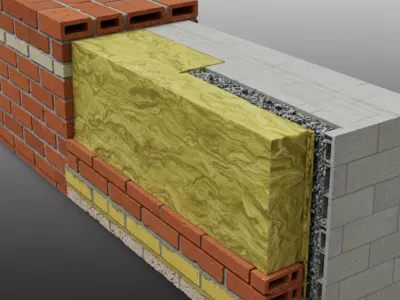Who Qualify For Free Insulation Grant?
If you are looking for eligibility criteria to check who qualifies for the UK’s free insulation grant, let us help you. There are multiple insulation options available under GBIS. It is an installer-led grant so you have to connect with an installer to apply for a free grant. If you want to qualify for a grant without paying a penny, you can connect with ECO Grant UK and get free insulation.
Introduction to Great British Insulation Grant
In the UK, free insulation grants are part of government-backed schemes aimed at helping households improve energy efficiency and reduce energy bills. Insulation is one of the most effective ways to keep homes warm during colder months and cool during the summer, enhancing overall comfort and cutting down energy costs.
Proper insulation can make a significant difference in energy efficiency, lowering heating expenses and minimizing carbon footprints. Given the rising concerns about energy costs and environmental sustainability, these grants are more valuable than ever.
This guide will walk you through everything you need to know about insulation grants in the UK. We’ll discuss eligibility criteria, the application process, the benefits of insulation, and what the grants cover. Whether you’re a homeowner or tenant, understanding how these grants work can save you money and contribute to a greener environment.
This guide will walk you through everything you need to know about insulation grants in the UK. We’ll discuss eligibility criteria, the application process, the benefits of insulation, and what the grants cover. Whether you’re a homeowner or tenant, understanding how these grants work can save you money and contribute to a greener environment.

What is Free Insulation Grant?
The Free Insulation Grant is a government-backed initiative aimed at helping UK households improve their energy efficiency through various insulation measures. These grants are provided under schemes like the Energy Company Obligation (ECO) Scheme, Home Upgrade Scheme (HUG), ECO Flex, and Local Authority Delivery (LAD) Scheme. The primary goal of these schemes is to reduce energy consumption, lower heating costs, and contribute towards the UK’s ambitious carbon neutrality target by 2050.
Apply For Domestic Insulation Grant
The Free Insulation Grant Scheme provides free insulation upgrades to eligible UK households. If you’re a low-income homeowner or tenant, check your eligibility and apply to lower your energy bills. Here’s the simple 3 step method of getting free grant:

Contact & Share Documents

Eligibility Verification & Survey

Approval and Installation
Qualify for Any Available Insulation Grant and Get Free Boiler Installation/Replacement
Types of Available Insulations Grants
The insulation grants cover various types of insulation to cater to different property structures and requirements:
These grants are available for qualifying households, especially those on low income or receiving specific benefits. By taking advantage of these schemes, homeowners and tenants can drastically improve their home’s energy efficiency and reduce their energy bills.
Why Government is Offering Free Insulation Grants?
The UK government has launched these insulation grant programs to address two major concerns:
- Fuel Poverty: With energy prices rising, many households struggle to afford heating. Insulation grants help reduce heating bills, making homes warmer and more energy-efficient.
- Carbon Neutral Goals by 2050: By making homes more energy-efficient, the government aims to cut carbon emissions significantly, supporting its long-term climate change targets.
Homeowners, landlords, and tenants (including private renters or those in housing associations) may qualify. If you’re a tenant, make sure to get your landlord’s permission before applying, as insulation can’t be installed without it.

Eligibility Criteria for Free Insulation Grant
To qualify for a free insulation grant under various government schemes, certain eligibility requirements must be met. The criteria primarily focus on property ownership, energy performance ratings, and specific qualifying benefits.
General Eligibility Requirements:
With energy prices rising, many households struggle to afford heating. Insulation grants help reduce heating bills, making homes warmer and more energy-efficient.
Property Ownership
- Homeowners: Individuals who own their property are eligible to apply for insulation grants.
Private Renters: Tenants living in privately rented properties can also apply, but landlord permission is required before proceeding with the installation process.
Landlords with Eligible Tenants: Landlords may apply for grants if their tenants meet the eligibility criteria, especially if the property has a low energy performance rating.
Required EPC Rating
Energy Performance Certificates (EPC) measure a property’s energy efficiency. The insulation grants mainly target properties with low EPC ratings, specifically:
- D, E, F, G Ratings: Properties with these ratings are considered less energy efficient. Grants are aimed at improving their efficiency to reduce energy costs and carbon emissions.
- 15% Funding Limit for D-Rated Properties: While properties rated E, F, or G receive full funding, D-rated properties are only eligible for up to 15% funding, depending on individual circumstances.
Eligible Benefit Holders For Grant
Child Benefits
Housing Benefit
Income Support
Universal Credit
Child Tax Credits
Working Tax Credit
Pension Credit Saving
Pension Guarantee
Warm Home Discount
Job Seekers Allowance (JSA)
Employment & Support Allowance (ESA)
Disability Allowance
Additional Consideration For Free Grant
1- Age of Property
When applying for a free insulation grant, one of the most important considerations is the age of your property. Buildings constructed before 1983 are typically more suitable for cavity wall insulation. This is because properties built before this period often have uninsulated cavity walls, making them prime candidates for improvement through government-backed schemes.
2- Property Type
The eligibility and insulation process can vary depending on whether your home is a house, flat, stone-built property, or timber-framed structure. Different insulation methods are more suitable for certain property types, so the survey and recommendations will be tailored to your specific circumstances. For instance, stone and timber-framed properties may require specialized insulation techniques compared to standard brick-built homes.
3- Permission Requirements for Rented Properties
If you are a private renter, permission from your landlord is essential before proceeding with the insulation installation. While many landlords are supportive of measures that improve energy efficiency, especially when it can increase property value and lower energy bills for tenants, it’s important to obtain formal approval before starting the process. Landlords who have tenants receiving qualifying benefits are also encouraged to apply for grants to enhance their property’s energy efficiency.
4- ECO4 Changes in Eligibility
It is also crucial to understand the recent changes under the ECO4 scheme, which have impacted eligibility criteria. Unlike previous versions of the scheme, ECO4 places greater emphasis on targeting low-income and vulnerable households, especially those living in inefficient properties with EPC ratings of D, E, F, or G. The changes are part of the government’s broader strategy to combat fuel poverty and achieve carbon neutrality by 2050. Staying informed about these changes ensures you are well-prepared to make the most of the available grant opportunities.
Eligible Countries for Insulation Scheme

England

Scotland

Wales
What If You Don’t Qualify For Grant
If you find that you do not meet the eligibility criteria for the standard free insulation grant, there’s still hope. The UK government has introduced a flexible mechanism known as LA Flex (Local Authority Flexibility) under the ECO4 scheme. This initiative is designed to provide energy efficiency improvements to a broader range of households, even those who do not qualify through the standard eligibility route.
Understanding LA Flex
LA Flex allows local authorities to set their own criteria for grant eligibility, targeting vulnerable households or those on low incomes who may not receive specific benefits. Each council may have slightly different criteria, focusing on aspects like health conditions affected by cold homes, low-income households not receiving benefits, or other unique circumstances.
How to Apply Through LA Flex
To apply through the LA Flex route, you need to check with your local council to understand their specific eligibility requirements. Once your eligibility is confirmed, the process usually follows the same pattern as standard grants, including property surveys and installation by registered installers.
How Does The Process Work?
The journey to receiving free insulation begins with a straightforward application process. Most insulation grant providers offer an easy online application form where you provide essential details about your property, income, and eligibility criteria. Once you submit the application, the grants team evaluates your information to determine eligibility. If you qualify, they proceed to the next stage and arrange a property survey.
Step 1 : Application Process
The journey to receiving free insulation begins with a straightforward application process. Most insulation grant providers offer an easy online application form where you provide essential details about your property, income, and eligibility criteria. Once you submit the application, the grants team evaluates your information to determine eligibility. If you qualify, they proceed to the next stage and arrange a property survey.
Step 2: Free Survey & Inspection
After confirming eligibility, a free survey is conducted to assess your property’s insulation needs. A certified energy assessor visits your property to evaluate the existing insulation levels and identify areas that require improvement. Based on the survey, the assessor recommends suitable insulation measures such as loft insulation, wall insulation, or underfloor insulation. These recommendations aim to enhance your home’s energy efficiency and reduce heating costs.
Step 3: Installation
The final step involves the installation of the recommended insulation measures by certified and approved installers. They ensure safety and efficiency by following all necessary guidelines to provide high-quality workmanship. Additionally, installers adhere to strict COVID-19 safety protocols, ensuring the health and safety of homeowners during the installation process. The best part? If you qualify for the grant, the entire process – from the survey to the installation – is completely free of charge.
Types of Insulation Grants & It’s Criteria
Under the ECO4 insulation grant scheme in the UK, various types of insulation grants are available to help homeowners and tenants enhance their property’s energy efficiency. These grants aim to reduce carbon emissions and lower heating costs by providing free or heavily subsidized insulation solutions. Depending on your property’s needs and eligibility, you can benefit from different types of insulation grants designed to make your home warmer, more energy-efficient, and environmentally friendly. Below are some of the most common insulation grants you may qualify for.
Cavity Wall Insulation Grants
Cavity wall insulation grants are designed to help homeowners and eligible tenants improve the energy efficiency of their properties by filling the gaps between external and internal walls. This type of insulation is particularly effective for properties built after the 1920s that have uninsulated cavity walls.
Cavity wall insulation involves injecting insulating material into the gaps between the outer and inner walls of a property. The purpose is to reduce heat loss, enhance energy efficiency, and lower heating bills. The insulation material acts as a barrier, preventing cold air from entering the property and retaining warmth within

Installation Process
The installation process is straightforward. A qualified installer drills small holes into the external walls and insulating materials such as mineral wool, polystyrene beads, or polyurethane foam are then injected into the cavity. Once the insulation material is applied, the holes are sealed, leaving the property’s exterior intact. Mineral wool is cost-effective and fire-resistant, polystyrene beads provide excellent thermal efficiency.
Cost You Can Save
Installing cavity wall insulation can result in significant cost savings on annual energy bills. On average, homeowners can save around £200 to £300 per year, depending on the size and energy efficiency of the property. While the exact savings may vary, the reduced heating demand quickly compensates for the installation cost, especially when grants cover the expenses.
Criteria
To qualify for cavity wall insulation grants, your property must meet specific criteria. Typically, properties with uninsulated cavity walls and an EPC rating of D, E, F, or G are considered eligible. Additionally, applicants must either own their property or have landlord permission if they are private renters. Receiving certain income-related benefits can also increase eligibility under schemes like ECO4.
Loft Insulation Grant
Loft insulation grants are designed to assist homeowners and eligible tenants in enhancing the energy efficiency of their properties by properly insulating their lofts or attics. By preventing heat from escaping through the roof, loft insulation significantly reduces energy consumption and heating bills.
Loft insulation is a simple yet highly effective method of reducing heat loss in a property by installing insulating materials within the loft or attic space. Materials such as mineral wool, fiberglass, or foam boards are laid between and over the joists to create a thermal barrier that traps heat within the living space. This method ensures that warm air remains inside the house rather than escaping through the roof.
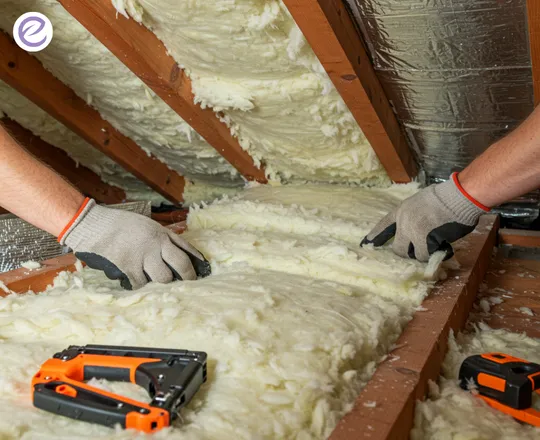
Benefits of Loft Insulation Grant
The benefits of loft insulation go beyond just comfort. Proper insulation can reduce annual heating bills by up to 25%, making it a cost-effective home improvement measure. Additionally, loft insulation contributes to lowering a property’s carbon footprint by reducing energy consumption, aligning with the government’s carbon neutrality goals. Properties with efficient loft insulation also tend to have higher Energy Performance Certificate (EPC) ratings, enhancing their overall value.
How to Qualify for a Loft Insulation Grant
Qualifying for a loft insulation grant requires meeting specific criteria related to property ownership, energy efficiency ratings, and personal circumstances. Homeowners and private renters with landlord permission are eligible to apply. Properties with EPC ratings of D, E, F, or G are prioritized, especially those inhabited by low-income or vulnerable households. Furthermore, receiving certain income-related benefits such as Universal Credit, Income Support, or Pension Credit can boost eligibility under the ECO4 scheme.
Cost Saving
The cost of installing loft insulation varies depending on the size of the property and the type of insulation material used. On average, the installation can save households between £250 to £400 per year on heating bills. The upfront cost is usually covered by the grant, making it a highly cost-effective solution for improving energy efficiency.
ECO4 Specific Eligibility Criteria
Under the ECO4 scheme, the focus is primarily on properties with low energy efficiency ratings and households receiving qualifying benefits. The scheme aims to target those most in need, particularly properties with EPC ratings of E, F, or G. While D-rated properties can receive partial funding, the majority of the grant support is aimed at improving the energy performance of homes with the poorest ratings.
External Wall Insulation Grant
External wall insulation grants are designed to assist homeowners and eligible tenants in enhancing their property’s energy efficiency by insulating solid external walls. This insulation method is especially beneficial for older properties, particularly those built before the 1920s, which usually have solid walls instead of cavity walls.
By applying insulation material to the exterior surface of the walls and covering it with protective render or cladding, external wall insulation helps to reduce heat loss significantly. It also improves weather resistance and soundproofing, while giving the property a fresh, modern appearance.
This type of insulation is particularly effective in lowering energy bills and making homes warmer during colder months. Under the ECO4 scheme, qualifying households can receive external wall insulation entirely free of charge or at a subsidized cost, making it a highly accessible solution for reducing energy consumption and enhancing overall comfort.
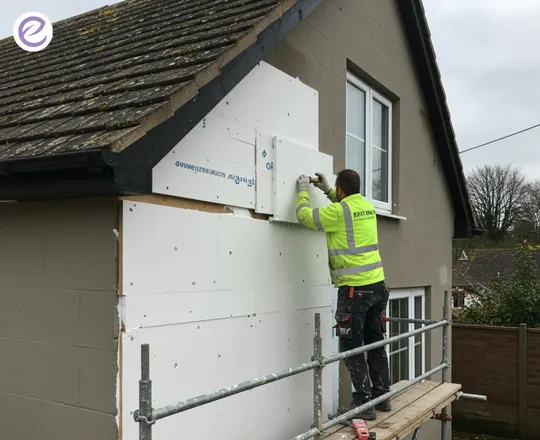
Installation of External Wall Insulation Grant
The installation process of external wall insulation involves fixing insulating materials, such as mineral wool, polystyrene boards, or phenolic boards, to the exterior of the property. Once the insulation boards are applied, they are covered with a protective layer of render or decorative cladding to enhance the appearance of the building and shield the insulation from weather damage.
Cost & Energy Efficiency Improvements
Installing external wall insulation can be quite costly, ranging from £8,000 to £22,000 for a typical semi-detached house. However, the energy savings are substantial. Homeowners can save between £300 to £500 per year on heating bills, depending on the property’s size and existing energy efficiency. While the initial investment is high, grant schemes like ECO4 can significantly reduce or eliminate costs for eligible applicants.
Benefits of External Wall Insulation Grant
The benefits of external wall insulation are significant. This method drastically reduces heat loss, enhances thermal efficiency, and lowers heating costs. Moreover, it improves waterproofing and soundproofing, contributing to a more comfortable indoor environment. Since external insulation does not interfere with the interior space, it’s a preferred option for those who wish to avoid disruptions within their homes. Additionally, it can improve the aesthetics of the property, giving older homes a modernized look.
Who Qualify For External Wall Insulation Grant
Eligibility for external wall insulation grants depends on various factors, including the property’s energy efficiency rating, ownership status, and the applicant’s financial circumstances. Properties with an EPC rating of D, E, F, or G are typically prioritized. Additionally, homeowners and private tenants with landlord permission are eligible to apply, especially those receiving certain government benefits such as Pension Credit, Universal Credit, or Income-Related Employment and Support Allowance. The ECO4 scheme focuses on helping low-income households improve their energy efficiency. As such, those receiving qualifying benefits are more likely to receive full funding, while others may still receive partial support depending on their circumstances.
Internal Wall Insulation Grant
Internal wall insulation grants are available to assist homeowners and tenants in enhancing their property’s energy efficiency by insulating the internal walls. This approach is particularly suitable for solid-walled properties where external insulation is not a viable option due to planning restrictions, aesthetic concerns, or budget constraints.
Internal wall insulation involves adding insulating materials to the interior side of external walls. It is an effective method for preventing heat loss and increasing the property’s thermal efficiency. The insulation is typically applied using rigid insulation boards or building insulated stud walls. While this method is less expensive than external insulation, it slightly reduces the room’s internal space.
The process requires careful planning, as fixtures like electrical sockets, radiators, and windowsills may need to be repositioned. However, it provides a convenient option for those who prefer to preserve the appearance of their property’s exterior.

Cost & Energy You Can Save
The cost of internal wall insulation generally ranges from £4,000 to £15,000, depending on the property’s size and the type of insulation material used. Despite the initial expense, the potential savings are significant, with homeowners typically saving between £200 to £400 per year on energy bills. Internal insulation is a cost-effective solution that greatly improves comfort levels and reduces carbon emissions.
Who can Qualify For Internal Wall Insulation Grant
Eligibility for internal wall insulation grants under the ECO4 scheme primarily focuses on properties with low energy efficiency ratings, particularly those with EPC ratings of E, F, or G. Properties with a D rating may still qualify, but funding is generally limited to 15% of the total cost.Applicants must be homeowners or private tenants with landlord permission, and eligibility is often linked to the receipt of qualifying benefits such as Universal Credit, Pension Credit, or Income Support. The grant’s purpose is to support vulnerable households in reducing their heating costs and improving overall energy efficiency.
Under Floor Insulation Grant
Under floor insulation grants are part of the UK government’s initiative to enhance energy efficiency and reduce carbon emissions in homes with suspended wooden floors. This type of insulation targets heat loss through the ground floor of a property, which can significantly contribute to higher energy bills if left unaddressed.
Under floor insulation involves fitting insulating materials beneath the floorboards of a property, typically in homes with suspended timber floors. It works by creating a barrier that prevents heat from escaping through gaps and draughts between the floorboards. This insulation method improves overall thermal efficiency, making homes warmer and more comfortable while reducing energy bills.
Insulating the floor is particularly effective in older properties where floorboards rest on joists, leaving an air gap between the floor and the ground. By filling this gap with insulation materials, heat retention is drastically improved, enhancing indoor comfort during colder months.
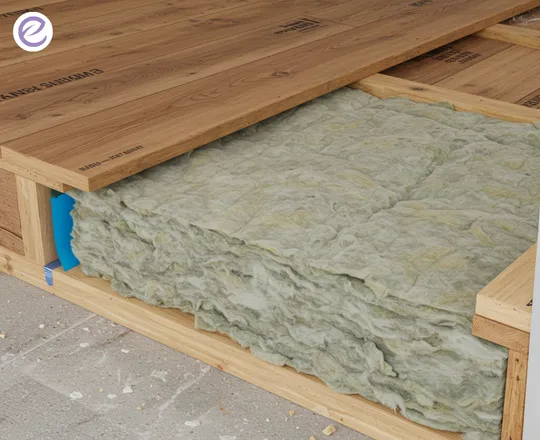
Installation & Benefits
The installation process for under floor insulation begins with a thorough survey of the property to determine suitability. If the property has a suspended timber floor, installers will lift the floorboards and place insulation materials such as mineral wool, foam boards, or natural wool between the joists. Once fitted, the floorboards are replaced, and the insulation is secured.
The benefits of under floor insulation are substantial. Homeowners can expect reduced energy bills, improved indoor comfort, and less draughty living spaces. The energy savings achieved depend on the property’s size and insulation quality, but annual savings of £50 to £100 are common.
Eligibility Criteria For Under Floor Insulation Grant
To qualify for under floor insulation grants under schemes like ECO4, the property must generally have an EPC rating of D, E, F, or G. Homeowners and tenants with landlord permission can apply, provided they meet the required criteria. Eligibility is also often determined by the applicant’s financial circumstances, with priority given to those receiving qualifying benefits such as Pension Credit, Income Support, Universal Credit, or Child Tax Credit.
Properties that are part of the Dual Measures scheme (combining insulation improvements with other energy-efficient measures) are particularly encouraged to apply. This approach allows applicants to benefit from multiple improvements simultaneously, resulting in greater overall energy savings.
Connection of Under Floor Grant with Dual Measures ECO Grant (Boiler Replacement Grants)
Under the ECO4 scheme, combining under floor insulation with other energy-efficient improvements, such as boiler replacement, is highly encouraged. This dual measure approach provides comprehensive energy efficiency enhancements that drastically reduce carbon emissions and energy bills. Those who qualify for under floor insulation grants may also be eligible for boiler replacement grants, particularly if they are receiving specific government benefits.
Taking advantage of the Dual Measures grant can significantly lower installation costs while maximizing the property’s energy efficiency. This approach is particularly beneficial for low-income households and those living in older, less efficient homes.
Solid Wall Insulation Grant
Solid wall insulation grants are designed to assist homeowners and eligible tenants in improving the thermal efficiency of properties with solid walls. Unlike cavity walls, solid walls do not have a gap for insulation, making them more challenging and costly to insulate. However, the potential energy savings are substantial, making this type of insulation a valuable improvement. Solid wall insulation can be applied either externally or internally, each method offering distinct benefits and drawbacks.
External solid wall insulation involves applying a layer of insulating material to the outside of the property, which is then covered with protective render or decorative cladding. This method offers excellent thermal efficiency while also enhancing the exterior appearance of the property. Additionally, it provides weatherproofing benefits and minimizes thermal bridging, but it is generally more expensive than internal insulation.
Internal solid wall insulation, on the other hand, involves fitting insulating material directly onto the interior walls of a property. Rigid insulation boards are commonly used, though stud walls filled with insulating materials can also be applied. While this method is usually cheaper than external insulation, it can reduce internal space and may require repositioning of electrical fittings, radiators, and other fixtures.
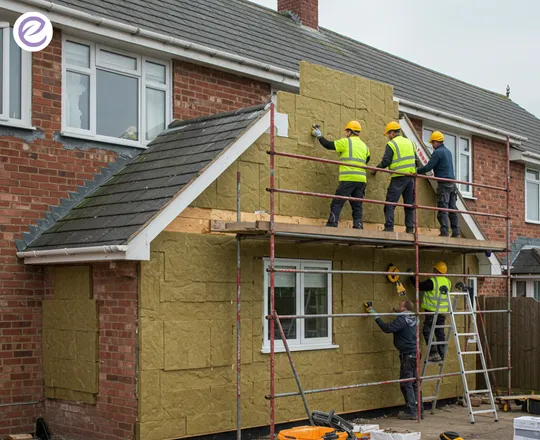
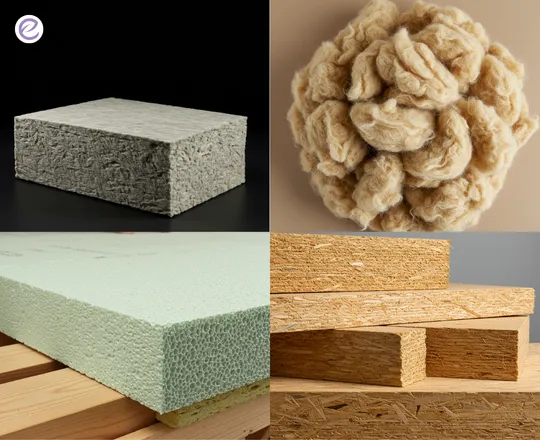
Type of Material Used For Insulation
Sheep’s Wool, Mineral Wool, etc. are commonly used for insulation. Various materials are commonly used for internal wall insulation, each offering distinct benefits.
- Mineral Wool: This is a popular choice due to its excellent thermal and acoustic insulation properties. It is also fire-resistant and cost-effective.
- Rigid Foam Boards: These boards offer high thermal efficiency and are ideal for properties where space-saving is a priority.
- Sheep’s Wool: A natural, eco-friendly insulation material known for its breathability and moisture-regulating properties. It’s an excellent choice for those seeking sustainable solutions.
- Wood Fiber Boards: These provide both thermal and acoustic insulation and are particularly suitable for period properties where breathability is essential.
Each material has its strengths, and the choice of insulation often depends on the property’s requirements, the homeowner’s preferences, and the grant’s coverage.
Benefits of Free Insulation Grant
Free insulation grants offer a wide range of benefits for eligible homeowners and tenants, improving energy efficiency, reducing costs, and enhancing overall comfort. Here’s a closer look at the key benefits:
- Insulating your home can lead to substantial savings on energy bills.
- By reducing heat loss, homeowners can expect annual savings ranging from £200 to £500, depending on the type of insulation installed.
- Lower energy bills mean improved financial stability, especially for low-income households struggling with high heating costs.
- Improved insulation enhances a property’s Energy Performance Certificate (EPC) rating, making it more attractive to potential buyers.
- Properties with better energy efficiency ratings generally have higher market values, providing long-term financial benefits.
- By minimizing heat loss and reducing the need for excessive heating, insulation helps lower carbon emissions.
- Contributing to the UK’s goal of achieving net-zero carbon emissions by 2050 is not only environmentally responsible but also eligible for government incentives.
- Enhanced insulation helps maintain consistent indoor temperatures, creating a more comfortable living environment.
- Improved warmth reduces the risk of dampness, condensation, and mold growth, promoting better health and well-being.
- Reduced draughts and cold spots improve overall comfort, particularly in older properties.
Why You Must Apply For Free Insulation Grant?
Applying for a free insulation grant is a smart decision for homeowners looking to improve energy efficiency and save money. Studies show that approximately 60% of UK households benefiting from insulation grants have experienced noticeable reductions in their energy bills. Proper insulation can reduce heat loss by up to 35% for walls and 25% for roofs, which translates to significant yearly savings.
For instance, households installing loft insulation can save up to £350 per year, while cavity wall insulation can save around £250 annually. External and internal wall insulation, although more expensive, can provide savings of £400 to £500 per year. Furthermore, the UK government aims to achieve net-zero carbon emissions by 2050, and improving household insulation plays a crucial role in this initiative. By reducing energy consumption and carbon emissions, insulation grants contribute directly to meeting these environmental targets.
Applying for a free insulation grant is not only beneficial for your finances but also supports a cleaner, greener future. With 100% funding available for qualifying households, this opportunity should not be missed.

Benefits of Free Insulation Grant
Free insulation grants offer a wide range of benefits for eligible homeowners and tenants, improving energy efficiency, reducing costs, and enhancing overall comfort. Here’s a closer look at the key benefits:
- Insulating your home can lead to substantial savings on energy bills.
- By reducing heat loss, homeowners can expect annual savings ranging from £200 to £500, depending on the type of insulation installed.
- Lower energy bills mean improved financial stability, especially for low-income households struggling with high heating costs.
- Improved insulation enhances a property’s Energy Performance Certificate (EPC) rating, making it more attractive to potential buyers.
- Properties with better energy efficiency ratings generally have higher market values, providing long-term financial benefits.
- By minimizing heat loss and reducing the need for excessive heating, insulation helps lower carbon emissions.
- Contributing to the UK’s goal of achieving net-zero carbon emissions by 2050 is not only environmentally responsible but also eligible for government incentives.
- Enhanced insulation helps maintain consistent indoor temperatures, creating a more comfortable living environment.
- Improved warmth reduces the risk of dampness, condensation, and mold growth, promoting better health and well-being.
- Reduced draughts and cold spots improve overall comfort, particularly in older properties.
Conclusion
Taking advantage of the free insulation grant offers numerous benefits, from cutting down on energy bills to enhancing your home’s comfort and value. Insulation helps reduce heat loss, resulting in significant annual savings and contributing to the UK’s commitment to achieving net-zero carbon emissions by 2050. Additionally, improved insulation reduces dampness, condensation, and draughts, creating a healthier living environment.
With the government’s initiative covering up to 100% of insulation costs for eligible households, there’s no better time to apply. Whether it’s loft insulation, cavity wall insulation, or under floor insulation, the financial and environmental advantages are undeniable. Don’t miss out on this incredible opportunity to improve your home’s energy efficiency while saving money. Apply for Your Free Insulation Grant Now!






